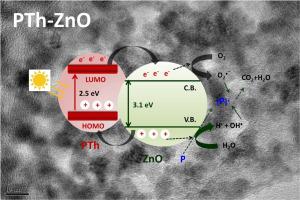Materials Today Communications ( IF 3.7 ) Pub Date : 2020-03-04 , DOI: 10.1016/j.mtcomm.2020.101048 M. Faisal , Farid A. Harraz , Mohammed Jalalah , Mabkhoot Alsaiari , S.A. Al-Sayari , M.S. Al-Assiri

|
The present work aims to enhance the photocatalytic performance of mesoporous ZnO by doping with polythiophene (PTh) for the treatment of toxic pollutants. Polythiophene doped ZnO (PTh/ZnO) photocatalysts with various weight percentages of PTh (1–10%) were synthesized via modified sol-gel and oxidative polymerization techniques. The XRD patterns revealed a well-crystalline hexagonal wurtzite phase of ZnO, whereas the XPS, FTIR and Raman spectra confirmed the successful coupling between PTh and ZnO nanostructures. TEM results illustrate the uniform distribution of PTh onto the mesoporous ZnO. UV–vis spectroscopy revealed a small lowering in bandgap energies upon PTh incorporation. The prepared PTh/ZnO nanostructures have been successfully exploited for the photocatalytic degradation of methylene blue dye (MB) and gemifloxacin mesylate (GFM) antibiotic. All doped samples exhibited superior performances in comparison to either pure PTh or undoped ZnO. The 5% PTh/ZnO showed the highest activity with 95 % degradation efficiency of MB dye in 180 min of irradiation with rate constant value 0.0156 min−1 which is almost 2.6 higher than pure ZnO. In addition to this, 5% PTh/ZnO proven to be highly active towards the degradation of gemifloxacin mesylate antibiotic after 180 min of irradiation time, yielding ∼80 % degradation efficiency. Repeated cyclic use of the current photocatalyst indicated excellent reusability and operational stability. The reaction mechanism involved during the photocatalytic degradation is also proposed.
中文翻译:

改性溶胶-凝胶和氧化聚合合成聚噻吩掺杂的ZnO纳米结构,用于亚甲基蓝和吉非沙星抗生素的有效光降解
本工作旨在通过掺杂聚噻吩(PTh)来处理有毒污染物,从而增强中孔ZnO的光催化性能。通过改进的溶胶-凝胶和氧化聚合技术合成了具有不同重量百分比的PTh(1-10%)的聚噻吩掺杂的ZnO(PTh / ZnO)光催化剂。XRD图谱显示出ZnO的六方纤锌矿纤晶相,而XPS,FTIR和拉曼光谱证实了PTh和ZnO纳米结构之间的成功耦合。TEM结果表明PTh在中孔ZnO上均匀分布。紫外可见光谱显示掺入PTh后带隙能量略有下降。制备的PTh / ZnO纳米结构已成功地用于亚甲基蓝染料(MB)和甲磺酸吉西沙星(GFM)抗生素的光催化降解。与纯PTh或未掺杂的ZnO相比,所有掺杂的样品均表现出优异的性能。5%PTh / ZnO在180分钟的辐照下具有最高的活性,MB染料的降解效率为95%,速率常数值为0.0156 min-1,比纯ZnO高几乎2.6。除此之外,在照射180分钟后,5%的PTh / ZnO被证明对甲磺酸吉西沙星抗生素的降解具有很高的活性,降解效率约为80%。当前光催化剂的重复循环使用表明了极好的可重复使用性和操作稳定性。还提出了光催化降解过程中涉及的反应机理。










































 京公网安备 11010802027423号
京公网安备 11010802027423号